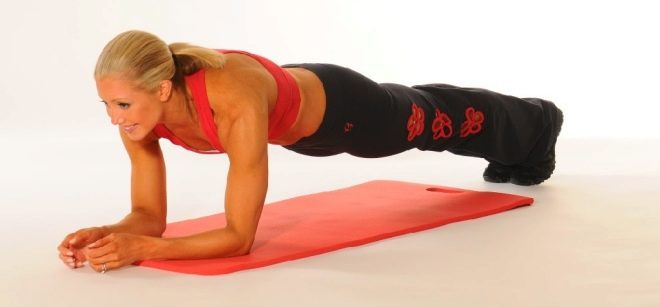Recovery after caesarean section. When can you start training?
Recovery from a cesarean section is slightly different from recovery from a vaginal birth.
During a cesarean section, the baby does not pass through the birth canal, so the intimate muscles are not overstretched, as during natural childbirth. But the pelvic floor muscles can lose tone during pregnancy from intra-abdominal pressure, and diastasis can also form - a separation of the rectus abdominis muscles. Organs shift during pregnancy, so be sure to start training only after receiving a doctor’s permission. Usually this is 1.5-2 months after childbirth, when a scar has already formed at the site of the suture, and the abdominal organs have returned to their usual places. You don’t need to start training with heavy weights, of course. You can start by doing light exercises at home, or jogging at a comfortable pace. To begin with, the muscles just need to tone up. The first workouts last 20-30 minutes and are performed 5-6 times a week. You can perform a simple complex, a link to which I will give at the end of the article, while the baby is sleeping. Circular training for all muscle groups is well suited - several 4-5 exercises for different muscle groups are performed in a row without rest for 10-15 repetitions, rest for 2-3 minutes between circles. First, we perform 2-3 laps per workout, over time we increase the number of laps to 5.
After a caesarean section, especially if the suture is transverse, the tummy seems to hang over the suture, and this practically does not depend on the size of the fat layer gained during pregnancy. Even thin girls have a small crease above their stomach. To remove this fold, you need to learn how to do the most important exercise for women who have given birth - a vacuum. The vacuum strengthens the abdominal muscles and teaches you to draw in your stomach. This is an indispensable exercise after a cesarean section, since it is not yet possible to pump up your abs and do various crunches, but you need to tighten your stomach. Having strong abdominal muscles, you constantly keep your stomach tucked in, it becomes a habit, and you no longer notice, but your stomach is always tucked in. A tucked in stomach, straightened shoulders and correct posture - and you are already beautiful.
How to do the vacuum exercise. There are many options - standing, sitting, cat pose. Let's look at the basic principles. Choose a starting position that is comfortable for you, then exhale slowly and fully and draw in your abdominal muscles as much as possible. Stay in this position for 10-15 seconds, continuing to hold your breath. Next, we inhale and relax the muscles. We restore our breathing and repeat everything from the beginning. We do 5-6 approaches, increasing the number of approaches over time. This exercise can be done anywhere. The more often you remember and make a vacuum, the faster your tummy will tighten.
What exercises should you avoid after a cesarean section? Any exercises that strain the abdominal muscles - squats, deadlifts, platform leg presses, crunches, hanging leg raises, push-ups, bench presses - are definitely excluded for the first few months. If there were complications after or during childbirth, then you should forget about the exercises listed above for at least six months. An excellent option for home workouts or outdoor workouts are elastic bands and fitness bands. These equipment will help you do isolated exercises on the muscles of the legs, arms, chest and back, eliminating straining.
How to care for a seam. A caesarean section is a half-hearted operation involving an incision into the abdominal wall. The operation itself is simple, but the suture requires special care. The incision is made layer by layer; there are subtleties when twisting the tissues. Types of incision: vertical - from the navel to the pubic bone; transverse - done 3 cm below the middle between the navel and pubic bone; transverse arcuate - done along the suprapubic fold. After about a week, a scar forms on the uterus, and the suture heals. In the maternity hospital, the suture is treated and sterile dressings are changed, and a doctor monitors the condition of the suture. After discharge, the responsibility for caring for the suture falls on the young mother. To reduce pain, it is recommended to tie up the stomach with a diaper, or wear a postpartum bandage. At home, you need to regularly perform antiseptic treatment of the suture and apply a sterile bandage; after healing, the suture must be smeared with healing ointments prescribed by a doctor.
Basic recommendations after cesarean section:
1. Suture hygiene, timely dressings.
2. Do not lift weights more than 2 kg in the first month, with the exception of a baby. Try to lie down with the baby more, pick him up in a sitting position.
3. Do not make sudden movements, get out of bed, turn over on your side and lower your legs to the floor.
4. Wear loose clothing that prevents seam chafing.
5. After a shower, soak the seam with a soft cotton or paper towel.
How to reduce the visibility of a scar after healing:
1. Use special anti-scar ointments and creams.
2. Rub vitamin E from ampoules into the skin of the abdomen.
3. Do self-massage of the abdomen.
If there is any unusual discharge from the incision, fever or general malaise, you should immediately consult a doctor. There are early complications that occur in the first days and weeks after surgery, and late complications that can occur a month later. Only qualified medical personnel will correctly diagnose and prescribe treatment.
Source
The main rules for training the abs after a caesarean section
In memory of pregnancy and childbirth, a woman is left not only with a toddler in her arms, but also with changes in her figure. I want to get rid of my bulging belly immediately. And young mothers can’t wait to start training their abdominal muscles. Those who have experienced surgical childbirth are interested in: when can you pump up your abs after a caesarean section? One thing is clear - we can’t rush. After all, the recovery period in this case lasts longer than after a natural birth.
We have selected a set of abdominal exercises that are suitable for women after a caesarean section. In order to benefit from training, it is important not only to exercise regularly, but also to start on time.
Training restrictions
Strengthening the abs after a cesarean section is necessary. An elastic muscle corset is needed not only for beauty, it provides support for all internal organs located in the abdominal cavity and prevents the development of spinal curvatures. This is an excellent way to prevent diseases of the liver, stomach, pancreas, intestines, bladder and reproductive organs.
Exercising is useful, especially after a cesarean section, but we must not forget about rationing the load and chronic diseases. It is necessary to limit physical stress in case of cholecystitis, pancreatitis, cervical osteochondrosis, neuralgia, cerebrovascular accidents, vegetative-vascular dystonia, migraines.
Attention! Exercises to strengthen the abs increase the load on all organs and can provoke an exacerbation. In case of any deterioration in health, further activities should be postponed and consult a doctor to find out the reasons.
Belly after cesarean
The belly after pregnancy and childbirth remains convex for a reason. During pregnancy, under the influence of hormones, muscles relax and lose tone. The body thereby protects the fetus from possible miscarriage. The uterus with the growing fetus stretches the muscles. And after childbirth we get a saggy tummy. The fat layer accumulated during pregnancy to protect the fetus also adds volume to the waist.
Some women develop a separation of the rectus abdominis muscles after childbirth, called diastasis. This pathology also looks like a bulging belly. And to restore the abdominal muscles during diastasis, you need to do special exercises.
Read more about diastasis after childbirth in our article.
The fold formed after a cesarean section above the scar looks like an overhanging bag and is called an apron. It appears due to a violation of the outflow of fluid in the tissues located above the scar. In some cases, it is necessary to resort to plastic surgery.
A protruding belly after childbirth is a familiar phenomenon to mothers who have given birth themselves and to those who have undergone a caesarean section. Getting rid of it will take time and hard training. However, if you start abdominal training too early, you can simply harm your health. Due to the increase in intra-abdominal pressure during training, there is a risk of suture dehiscence or the appearance of a postoperative hernia.
On topic: Abdominal pumping lessons for beginners
When can you pump up your abs after a caesarean section?
During the first 2 months after childbirth, a woman’s body recovers. The uterus is cleared of postpartum secretions and returns to its pre-pregnancy size. At this time, it is prohibited to pump up the press, both for mothers who gave birth naturally and for those who had a cesarean section.
When asked how long after a caesarean section you can pump up your abs, doctors answer - after 6-9 months. By this time, the suture on the uterus and abdomen will be healed, and the risk of its divergence during training will be minimal. After a repeat cesarean section, you need to wait at least 12 months to start training your abdominal muscles.
Before starting abdominal training, every mother should consult a gynecologist. If necessary, do an ultrasound of the suture to make sure it is intact. Only after your doctor’s approval can you begin training your abdominal muscles. Before consulting with your doctor, you should not exercise any abdominal muscles: neither straight, nor lateral, nor oblique. Rushing in this matter can not only delay the return of a thin waist, but also harm your health.

During training, it is important to monitor your well-being and listen to body signals. If you experience the slightest discomfort or pain in the suture area, you should immediately stop exercising. Even if the doctor has given permission to train, but you feel that the classes are difficult, listen to yourself. You shouldn't force yourself. Each person's body is individual.
Why does a belly appear after childbirth?
- Nature has decreed that during pregnancy the body changes. An additional layer of fat appears mainly in the area of the hips, pelvis and abdomen - this is necessary for additional protection of the baby. This distribution of fat is regulated hormonally and is therefore poorly controlled from the outside. The expectant mother can only influence as much as she can on the intensity of the “protective layer” - proper nutrition will not allow the body to acquire shapeless shapes and will facilitate postpartum work on oneself.
- In addition, by the end of pregnancy, the uterus, a hollow muscular organ in which the fetus develops, enlarges many times. After childbirth, the uterus immediately begins to return to its usual volume, but this process takes some time (at least 2 months). The organ contracts faster during feeding, when oxytocin is released. At the same time, the uterus, injured during a caesarean section, returns to its original shape much more slowly.
- During pregnancy, the abdominal muscles also stretch, succumbing to the pressure of the growing uterus. The elastic and “working” muscles of an athletic and active woman will return to their previous shape faster and more readily.
- Another reason for the changed shape of the abdomen is diastasis (divergence of the muscles of the abdominal area). If a gap appears between the muscles, it will not be possible to achieve the previous plane.
- The muscles of the “lower abs” are also deformed due to weakening of the pelvic floor muscles. An enlarged belly with a significant “load” is a serious load for the muscles supporting the uterus, which also takes part in the process of pushing out the child.
- The topmost layer, the skin covering the abdomen, also stretches. Sometimes stretch marks (stretch marks) appear on the skin, which are caused by changes in hormonal levels and rapidly increasing volumes.
Exercises for the abs
“The main rule during abdominal training is a gradual and smooth increase in load. You can prepare your body for exercise just a few weeks after giving birth.”
Immediately after childbirth, wearing a bandage will help strengthen your abdominal muscles. But no longer than 2-3 hours in a row, because the abdominal muscles must learn to work. Carrying a baby in a sling also puts some stress on the abdominal muscles and thereby trains them. After the lochia ends, with the permission of the doctor, you can visit the pool. During swimming, all muscles work. This reflects in the best way on the figure. You can start with warm-up exercises, doing planks, and breathing exercises. We wrote about this in the article “Sports after Caesarean”.
General rules
To play sports after a cesarean section, follow the general recommendations and rules:
- At the beginning of each session, do a warm-up to warm up and prepare your muscles for work. You can do a couple of body bends, pull your knees towards your stomach, etc. At the end of the session, do some stretching as a cool-down.
- You need to pump up your abs regularly. At least 3 times a week. The abdominal muscles are very inflexible. To get results, training must be constant.
- Movements during exercises should be with minimal amplitude. Perform no more than 10-12 times in one approach.
A set of exercises for abdominal training
So, six months or more passed after the cesarean section, and the doctor allowed me to pump up my abs. Of course, classes with an instructor are the best possible option. But not all young mothers can afford to go to the gym. Therefore, practicing at home on your own is a suitable alternative.
Abdominal training scheme:
Starting position: lying on your back, hands behind your head. Bend your knees 90° and raise them parallel to the floor. As you exhale, lift your head and shoulders off the floor. Do 2 sets of 10 reps.
Starting position: lying on the floor, legs bent at the knees and placed towards the buttocks, arms bent at the elbows and placed in front of you. As you exhale, raise your head and shoulders. Bend your knees to the right, turn your body to the left. Perform 2 sets of 10 times.
Starting position: lying on your back, arms along your body. As you exhale, raise your legs straight at an angle of 30°. Stay in this position for 30 seconds. Do 2 sets of 10 reps.
Starting position: standing against the wall, holding the ball between your legs. Squat with a straight back for 2 sets of 10 times.
- Jump Squats
Starting position: standing, feet shoulder-width apart. Squat with a straight back, straighten up and jump up. Perform 2 sets of 10 times.
- Crunch for obliques
Starting position: lying on your back, hands behind your head. As you exhale, raise your head and shoulders and reach your right knee with the elbow of your left hand. Reach your right elbow towards your left knee. Repeat 2 sets of 10 times.
Starting position: lying on your back, hands behind your head. Legs are bent at the knees and raised 90 degrees. Make rotational movements, simulating riding a bicycle.
It takes about six months to restore the body after a caesarean section. This time can be devoted to preparing the body for sports activities. As for the question - is it possible to pump up the abs after a cesarean section - of course, yes. At the same time, remember the rule of gradual and smooth increase in loads.
Source
Best Traditional Exercises
You can regain good physical shape by performing a set of exercises at home. When about 3 months have passed since the operation, you can also introduce training into your daily exercise program. To get started, 10 minutes a day will be enough. The practice time can be gradually increased, but not more than 1-2 minutes per day. The optimal training intensity is 3 times a week. Add abdominal exercises last, after about six months have passed.
Dumbbells, which are a completely natural addition to the traditional gymnastics complex, are contraindicated after a caesarean section. Therefore, classes should be planned using effective, but not exhausting exercises.
"Bridge". This exercise will be useful for both the abdominal muscles and thighs. Starting position: lying on your back. Bend your legs, place them on your feet, try to raise your hips as high as possible, hold for a few seconds and smoothly lower back.

- Kegel exercises. To a greater extent, this set of exercises to strengthen the pelvic floor and vagina is important for women who gave birth naturally, but even after a caesarean section, the pelvic floor muscles are somewhat relaxed. You can get them in shape and thereby improve the quality of sex and your own self-esteem using a few simple techniques. Squeeze and unclench your vaginal muscles. After a 10-second load, take a break of the same duration and repeat the exercise again. Gradually increase the compression time and reduce the number of approaches.
If at first they do three approaches of 10 seconds each, then in the final there is already 1 approach with a half-minute period of squeezing the vaginal muscles.

- "Plank". Everyone has heard about the benefits of this exercise. After a caesarean section, it should be introduced into gymnastics no earlier than 6 months later. From a lying position on her stomach, facing the floor, the woman needs to raise her torso on her elbows and toes. The torso should become parallel to the floor surface. You need to hold this state for 10 seconds to half a minute.

- "Mill". Circular movements of the arms from the shoulder can be useful for maintaining muscle tone not only in the shoulder girdle, but also in the hips. The main thing is to maintain your posture and increase the diameter of the circles with each subsequent swing.

- "Vacuum". This is a yoga exercise, and untrained women may find it incredibly difficult. In fact, the “Vacuum” exercise is much simpler than it seems. It helps to reduce the waist and also strengthens the abdominal muscles, including those that have been cut with a scalpel (aponeurosis and rectus abdominis). It is recommended to do it on an empty stomach before your morning meal. A woman needs to inhale deeply and exhale through her mouth so as to empty her lungs as much as possible, after which the anterior abdominal wall will begin to approach the spine.
Various options with poses are possible - you can do the “Vacuum” standing, sitting, lying down or on all fours.

Timing when you can pump up your abs after cesarean section, and training options for a flat stomach

After a caesarean section, you should start doing abdominal exercises no earlier than 3-4 months later, and provided that the operation was carried out as standard. In case of complications, multiple pregnancy, or not the first operation, the start date of training is delayed. You cannot immediately start exercising, as this will lead to the development of complications (suture dehiscence, hernia protrusion, bleeding, uterine prolapse, etc.) and unpleasant long-term consequences.
At the same time, it is necessary to monitor your diet and daily routine, and also not avoid general physical activity in the form of walks. To improve the condition of your abs, it is useful to breastfeed. The first sets of exercises should contain more static options, as well as breathing exercises. The load should be expanded gradually. Each complex ends with stretching, which also becomes more difficult as the woman regains her shape.
A year after the operation, the mother can fully regain her physical fitness if she follows simple recommendations for this process.
Doctors' recommendations
Until the end of rehabilitation after obstetric surgery, any sports activities are prohibited for a woman. You can start your first classes no earlier than after 3–4 months. This does not mean a complete lack of physical activity. A young mother has to work like never before to care for her baby.
To strengthen the abdominal muscles in the first weeks, it is recommended to wear a support bandage. It relieves stress from the spine, preventing further sagging of the abdomen, and helps prevent pain.
The permitted time when you can pump up your abs after a caesarean section may come in six months or later. It all depends on the progress of the operation and the health problems that followed. The condition of the seam matters. A traditional transverse suture along the supra-pubic line is less susceptible to dehiscence. The longitudinal one, crossing the muscle fibers in the direction from the pubis to the umbilical opening, requires closer attention. It heals more slowly and more often causes hernias to form. Improper abdominal exercises can lead to increased physical tension and cause complications.
Exercise machines may be the solution. Fitball is a gymnastic ball that holds most of the weight during exercise, prevents impact loads, and prevents injuries. Even the usual rolling of a ball, lying on it with your stomach or maintaining balance while sitting helps to work out the abdominal muscles well.
A good way to get back into shape is swimming and water gymnastics.
In addition to sports activities, a healthy diet is necessary to reduce belly fat. The restrictions that breastfeeding mothers have to adhere to usually help maintain normal weight. In addition, a significant part of the nutrients is used to replenish internal resources spent on milk synthesis. Mothers of artificial babies need more careful attention to the energy value of the diet and the range of products. If during pregnancy your weight has increased by more than 10% of the original weight, it is recommended to reduce calories, providing only the physiological needs of the body and replenishing daily physical costs. You need to eat in moderation, but nutritiously: include vegetables, berries, animal protein, fermented milk products, cereals, lean meat and fish of various types in your menu every day.
It is recommended to limit sugar and salt, as well as confectionery, smoked meats, marinades, and fast food.
You can’t starve or go on mono-diets. This provokes metabolic disorders, leads to dehydration and hypovitaminosis, but does not help strengthen the muscle corset.
When can you pump up your abs after a caesarean section?
You can start pumping up your abs after a caesarean section on average 3-4 months after the operation. But exercises on the abdominal muscles should be done very carefully. You also need to take into account additional factors that influence the start date of classes.
Complications of the operation
A longitudinal suture (from the navel to the pubis) on the anterior abdominal wall increases the risk of developing hernias. Difficulties with healing and development of a normal scar increase.
Often this type of dissection is performed during an emergency operation, the circumstances of which also impair regeneration in this area.
All surgical interventions on the uterus and pelvic organs increase the burden on the body and contribute to a higher risk of early complications.
Each subsequent cut on the organ takes longer to heal, and the conditions for regeneration are more stringent.
The stretching of the uterus during multiple pregnancy is higher, which requires greater contraction after childbirth. This process takes longer the more children there were.
Also, the mother’s body needs more time to rehabilitate after giving birth to several children.
If you have twins, you can start training after 4 months, if you have triplets, after 5 months.
Each child on average extends the period by 1-1.5 months
Long-term complications
If inflammation or infection develops after surgery, then all physical activity is contraindicated until recovery.
They approach exercise with great caution if there is an imbalance in hormonal status or if there are problems with lactation.
Only a doctor can finally resolve serious physical activity, especially if the birth occurred with complications.
How to start training your abs after a cesarean section
You need to start pumping up your abs after a cesarean section by following simple rules:
- increase intensity by 5-10% per week;
- choose static abdominal approaches as your first exercises;
- warm up the body before training with light aerobic exercise;
- avoid pain during exercise, and if it occurs, stop training;
- exercise after breastfeeding;
- do not train if you are overworked or ill;
- exercise regularly;
- do not use the child in training;
- strictly adhere to the deadlines;
- do not use burning or warming creams during training;
- take rest days in training;
- use breathing exercises.
On the subject: Calendar for pumping the press
Regarding the training itself, the following is recommended:
- start with light loads;
- pause between sets for 1-3 minutes;
- at the end it is better to do light muscle stretching;
- train 1.5 hours after eating;
- when thirst appears, drink water in small sips;
- coordinate exercises with breathing: load as you exhale, relaxation as you inhale;
- monitor heart rate (heart rate) and blood pressure (blood pressure) during exercise;
- combine abdominal exercises with other light activities.
Playing sports should bring mild fatigue and satisfaction. You should not overload yourself in an effort to get back into shape as quickly as possible.
And here is more information about how to lose weight after a cesarean section.
When to stop
If the following signs appear, you should stop training altogether:
- dizziness;
- headache;
- flickering of flies before the eyes;
- sharp pain in the abdomen;
- the appearance of bloody discharge from the genital tract;
- heartbeat;
- rhythm disturbance.
If, during exercise, nagging pain in the lower abdomen appears, and it does not lose its intensity for 7-10 days, then it is better to stop training until you feel better.
Each session should cause moderate stress: heart rate should increase by 10-15% at the beginning of training. After 7-8 months you can train in a more intensive mode. You can also alternate aerobic exercise in the form of an intense walk and exercise: do a set of abdominal exercises after a daily walk with your child in the park and finish it all with stretching, after which you can take a walk again in the evening.
Down with the folds
Abdominal exercises, in addition to strengthening muscle tissue, also concern aesthetically unattractive folds on the abdomen, which are quite difficult to deal with. The following movements can help with this:
- Standing straight, you need to pull in your stomach and bend to the sides. After several workouts, you can perform the exercise with your arm outstretched;
- Standing on all fours, pull in/relax your stomach;
- Lying sideways, you need to swing your limbs, from one side to the other;
- The “Scissors” exercise has increased effectiveness against wrinkles, although maximum care must be taken when performing it;
- Lying on the floor, you need to bend your limbs, pulling them as close to your chest as possible. You should start with 5-8 approaches.
Doing squats and half squats is also helpful.
Is it always possible to pump up your abs after a caesarean section?
After a cesarean section, it is not always possible to pump up the abs in the medium term (4-5 months); often the onset period is delayed when:
- the presence of inflammation or infection in the pelvis (endometritis, adnexitis, salpingoophoritis);
- diseases of the excretory system during exacerbation;
- state of fever;
- severe anemia;
- development of endometriosis with frequent bleeding;
- malignant neoplasms with metabolic disorders, general condition;
- decompensation of somatic diseases after childbirth (cardiovascular, liver or kidney failure, diabetes mellitus);
- rhythm disturbances;
- high blood pressure;
- gestosis, eclampsia and severe toxicosis (the rest period is significantly longer);
- failure of scar tissue;
- abdominal hernias;
- severe leukopenia and thrombocytopenia, as well as severe diseases of the hematopoietic system (hemorrhagic diathesis with severe hemorrhagic syndrome, and so on);
- decompensation of metabolic disorders;
- increased intracranial pressure;
- carrying out diagnostic and therapeutic instrumental manipulations on the genitals (curettage).
Endometriosis
In these cases, it is better to postpone restoration of physical fitness and abs until complete recovery (determined only by a specialist).
Loads should be taken more carefully even if there are problems with lactation: often a change in the usual lifestyle and lack of sleep becomes a big stress for the mother, which affects breastfeeding. If milk has disappeared, then until this function is restored, you should not overload yourself with training, which also activates all the stress systems of the body.
What are the dangers of early training?
Early training after surgery can lead to complications:
- bleeding;
- scar divergence;
- suture failure;
- decompensation of concomitant diseases;
- decreased immunity, including local immunity, and the development of infectious and inflammatory complications;
- development of hernias in the area of the anterior wall;
- excessive load on the spine and its weakening;
- development of reproductive diseases: endometriosis, cysts, myomatous nodes, algodismenorrhea;
- increased intra-abdominal pressure;
- prolapse of the uterus and rectum;
- prolapse of hemorrhoids;
- bleeding from hemorrhoids;
- hormonal imbalance;
- secondary hypogalactia (decreased milk production).
Uterine prolapse
Early training is considered to be training started before 3 months with a normal birth, first operation and one child.
If there were complications, numerous operations or multiple pregnancies, then the period is calculated individually. For example: the mother had a second cesarean operation, multiple pregnancy, and had preeclampsia. This means that another 3-4 months are added to the usual period of 3 months for rehabilitation due to such a complex medical history.
In this case, in at least six months, you can start training, or it’s even better to wait 7 months and check the condition of the genital organs with an ultrasound and a gynecologist.
What is absolutely forbidden to do?
- First of all, you should not regard the rehabilitation period as a reason to put yourself on a strict diet - a nursing mother needs good nutrition. Breast milk provides the baby with everything necessary for development and growth; nutrients are “removed” from the mother’s body. Cutting back on food in such a situation will only harm yourself. Teeth, hair, nails and skin are deprived of nourishment, health suffers, drowsiness and loss of strength appear. Hormonal changes accompanied by diet are guaranteed nervous breakdowns and postpartum depression. However, a balanced diet does not mean that you should eat “empty calories”. Floury and sweet foods are of no use to either mother or child.
- There is no need to rush into all seriousness without a doctor’s permission. Yes, childbirth and pregnancy are not a disease, but a heavy load, accompanied by hormonal changes and recovery. Additional stress and interference with the body's functioning is a cesarean section. Follow your doctor's recommendations and adhere to the recommended time frame.
- You can’t start with intense weight training and exhausting training programs. Crossfit and marathon running can wait. At first, light and regular loads are acceptable.
Restoration of the prenatal form occurs gradually, and in the case of a cesarean section, any stress requires careful adherence to medical recommendations and a rehabilitation period. In any case, everything depends only on the woman herself: for those who believe in themselves, there are no impossible goals!
Especially for beremennost.net – Elena Kichak
Is it possible to pump up abs quickly after a caesarean section?
After a caesarean section, you won’t be able to pump up your abs quickly; you can only worsen your condition, and this is due to the following:
- During pregnancy, the skin stretches and the tone of the abdominal muscles decreases. This leads to slower rehabilitation and a longer recovery of the previous tone. Sometimes excess skin is not removed at all.
- Due to the suture and scar formation, normal fat deposition in the subcutaneous fat may be disrupted. This will increase your waist size, and your workouts will not be as effective.
- Women experience a lot of stress and often do not adhere to dietary and other recommendations. This is reflected in appearance and ability to exercise.
- Intense training in the early stages causes pain and discomfort; patients quickly stop such exercises.
Abdominal muscles
The pace of increasing exercise after surgery depends on the woman’s condition, but it cannot be fast. It is considered optimal to increase approaches by 1-2 times every 2 weeks.
The pace of training is coordinated with the condition: when a comfortable level is reached, it is allowed to increase the intensity by 5-15%. This usually happens once a week for the first month. By 2-3 months of training, a certain stable level of physical activity is achieved, which should not be forced for at least a month.
On average, you can get in shape and pump up your abs by the end of the first year after surgery.
Watch this video about what exercises after a caesarean section will help you get back in shape:
How to pump up your abs after a caesarean section correctly
To pump up your abs after a caesarean section, you need to perform physical exercises correctly and select them individually, do not forget about warming up and slowly increasing the load.
Breathing exercises
During the second month after surgery, it is allowed to perform breathing exercises that strengthen the abdominal muscles:
- lie on your back, inhale for 3 counts and hold your breath, then exhale for 3 counts, repeat 10-12 times;
- in the same position, slowly inhale, inflating the stomach, and exhale, gently drawing it in without effort (not to be confused with a vacuum in the abdomen);
- inhale for 3 counts and exhale smoothly without delay 5-15 times;
- sit down and cross your legs: in this position the stomach tightens along with the act of breathing;
- inhale slowly and exhale in 3 counts without holding your breath 5-15 times.
This breathing exercise can be done several times a day. The rest of the time, you need to make sure that your stomach is pulled up, and for this you need to maintain your posture. You need to pull your shoulders back a little, straighten your chest, raise your head - in this position the stomach will naturally tighten.
Easy abdominal exercises
After 3-4 months you can start doing light exercises:
- Plank: you need to stand on your elbows and stretch your legs back, placing them on your toes. The body forms an even line: the back of the head, shoulders, shoulder blades, protruding points of the buttocks; you must not sink into the lower back or chest. Place your feet shoulder-width apart, spread your elbows on the floor, lower your head to a straight line. You need to stay in this position; here, in a static position, the muscles of the abs, back and legs work. First, the bar should be held for 30 seconds, then increased to several minutes. Do it every other day.
- Body bends: stand on your feet, place your hands on your waist, bending your elbows. Slowly lean to the right without lifting the opposite hip, then to the left. The pace should be kept low and the body kept straight. Do 15 bends in each direction. This exercise strengthens the side abdominal muscles.
- Raising the body from the floor: you need to lie on your back and bend your knees. In the first weeks of exercises, it is done with straight arms: they should be extended along the body, the body should be raised towards the bent legs. We must strive to ensure that it is the body that rises, and not the head or neck. To do this, keep your head straight and not tilt it towards your chest. Alternate lifts with pauses during the first approaches. You need to start with 5-7 times, increase 2 times per set every other day.
- Twisting: in the same position, alternately lift your hand from one side to the thigh on the other side, while twisting your body. Do the twisting 5-7 times in each direction slowly.
- Pull up the body from the sides: lying on your back with bent legs, straighten your arms along the body. Stretch your arms in each direction (stretch your right side to the right, your left side to the right), trying to reach your ankle with your hand. Repeat 5-10 times in each direction with a break.
On topic: Proper nutrition to pump up your abs
This complex will be sufficient during the first weeks. You can then increase reps and sets, and speed up the tempo.
Advanced workouts: option 1
After a month of successful training, you can try to complicate them:
- Raising the body: bend your arms at the elbows behind your head and lift the body to your knees, pausing at the top point, then lower down. Do 15 repetitions per set.
- Twist: place your hands behind your head and twist one by one to the side, trying to touch your elbow with your knee. Repeat 15 times. At the end of the approaches, you can do a quick twist in both directions for 30 seconds.
- Lying on your back, raise your legs alternately. First to the level of 15 degrees, then 45, then 90. 15 repetitions per set.
- Raise your legs straight until they are perpendicular to your body, lift your body to your straight legs. 15 repetitions per set.
- In a position with legs raised, perform twists, 15 times per approach.
It is enough to work out such a complex 3-4 times a week.
After exercise you need to do some stretching:
- Sit on the floor, spread your legs wide, tilt your body alternately in one direction and the other towards your straight leg.
- In the same position, tilt the body to the sides, linger at the bottom; tension and stretching of the muscles should be felt on the sides.
- While standing, tilt your body to one side and pause, then tilt it to the other.
- Sit down and cross your legs, turn your body to one side and place your hand behind you, then to the other.
For each stretching exercise to be effective, you need to spend at least a minute; in the stretched position, the body should be fixed for 30 seconds so that the tension in the muscle fibers is felt.
Advanced workouts: option 2
After 2 months of light exercises, the complex can also be supplemented with the following more complex exercises:
- perform body twisting with leg pull-ups from a lying position, 15 times per approach;
- lift straightened legs and pelvis from the floor, this is how the muscles of the lower abdomen are trained, repeat 10-15 times, then add body lifting to this exercise;
- on the horizontal bar, stretch out on your arms and raise straight or bent legs until they are parallel to the floor;
- from the plank position, pull your legs alternately to each hand: first to your own, then to the opposite side.
The complex should also be completed with stretching. You can perform several yoga asanas:
- spread your legs wide, spread your arms to the sides and bend towards the unfolded leg, reach your ankles with your hands, hold;
- lie on your stomach, place your hands under your shoulders and raise your neck and chest, hold;
- From the same position, fully straighten your body and arms, feel the tension in your abdominal muscles.
A difficult but effective stretching pose is the bridge: you need to stand on your feet and tilt your body back, standing on your hands. But such a complex exercise can only be performed after the rehabilitation period is completed.
Watch this video about the most effective abdominal exercises:
How to get your abs back without exercise after a caesarean section
You can quickly restore your shape and abs only if the postoperative period proceeds favorably and there are no complications. Therefore, one should strive to maintain such a state above all. To speed up the process, you should:
- wear a bandage after surgery, and also use it before giving birth;
- eat nutritiously, but with dietary restrictions;
- breastfeed (improves metabolism);
- avoid hypothermia and contact with infectious patients;
- sleep fully if possible;
- if severe stress reactions develop, take sedatives, taking into account restrictions on medications during lactation;
- walk in the fresh air at least 3-4 times a week for forty minutes;
- follow the rules for starting training after childbirth.
Nutrition
The diet should:
- avoid fatty, fried, sweet, smoked foods;
- consume 400-500 g of fiber per day in vegetables and fruits;
- do not drink strong tea and coffee;
- drink at least 2 liters of liquid per day;
- Taking into account lactation, give preference to warm fruit drinks and compotes;
- do not eat butter and flour;
- prefer lean varieties of meat and fish;
- season food with vegetable oils, replenishing reserves of unsaturated fatty fats;
- do not practice fasting days;
- include greens in salads;
- prefer seasonal vegetables and fruits;
- limit animal fats (margarine, palm oil);
- limit foods that cause flatulence (legumes, fresh bread, whole milk, some vegetables);
- the share of protein products should be at least 25%;
- cook soups with low-fat broth;
- reduce the amount of salt when edema develops;
- After training, eat protein foods, and before them – carbohydrate foods;
- increase the amount of cereals, cook them in water and half with milk.
Example of a diet after a cesarean section
This will speed up metabolic processes and allow you to exercise more actively. Nutrition plays a big role in training. You should not consume fat-burning foods or sports supplements while breastfeeding. It is beneficial to take multivitamin supplements for nursing mothers.
Wraps
To reduce your waist, you can apply wraps to the scar area, as well as take baths. Such procedures are optimally carried out 4-5 months after surgery, so as not to harm skin regeneration and restoration of the uterus. Honey, seaweed, and vegetable oils can be used as wrapping products. Sea salt should be avoided.











